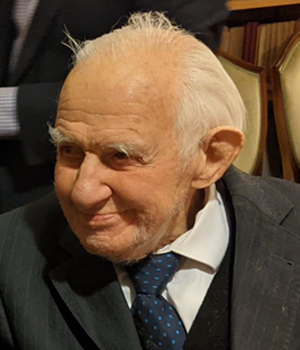 James V. Kinnier Wilson, Assyriologist at the University of Cambridge and Fellow of Wolfson College, Cambridge, died on 22 December 2022, less than a month after his 101st birthday. From the 1950s to the 1980s, he was the mainstay of Assyriology at the University of Cambridge and stayed on in Cambridge after retirement, to the last always pleased to see younger colleagues and engage in agreeable conversation. He was the epigraphist for the Nimrud excavations in the early 1960s and had a lifelong interest in Mesopotamian medicine.
James V. Kinnier Wilson, Assyriologist at the University of Cambridge and Fellow of Wolfson College, Cambridge, died on 22 December 2022, less than a month after his 101st birthday. From the 1950s to the 1980s, he was the mainstay of Assyriology at the University of Cambridge and stayed on in Cambridge after retirement, to the last always pleased to see younger colleagues and engage in agreeable conversation. He was the epigraphist for the Nimrud excavations in the early 1960s and had a lifelong interest in Mesopotamian medicine.
After Fettes College in Edinburgh, where he boarded from 1935 to 1940, James saw war service in India on the North-West frontier, moving to Burma in 1944 with the rank of Major. Thereafter his acquaintance with the Indus was partly responsible for his choice of subject at Exeter College, Oxford, where he studied Akkadian and Hebrew at the feet of Oliver Gurney and Godfrey Driver (BA 1949 and M.Litt. 1950). He then moved first to Durham for a year, as the colleague of the Egyptologist T.W. Thacker, and next to Chicago in 1951–52, where he worked on the Chicago Assyrian Dictionary. He undertook the edition of the plant list Uruanna=Mashtakal, and he fondly remembered his time in the (then) Oriental Institute, in the inspiring company of Benno Landsberger, Leo Oppenheim, I. J. Gelb and Thorkild Jacobsen. After a spell in Toronto, he was appointed to the Eric Yarrow Lectureship in Assyriology at the University of Cambridge in 1955, and in partnership with Margaret Munn-Rankin he established and developed the Assyriology course there until his eventual retirement from the Faculty of Oriental Studies in 1989. In 2018, he delivered the opening words as narrator for the Poor Man of Nippur film produced by Martin Worthington, for the Department of Archaeology at the University of Cambridge.
James was one of the early participants in the Rencontres Assyriologiques Internationales, where he enjoyed meeting R. Labat in particular. His ever-enquiring mind embraced a range of fascinating topics, reflected in the list of his monographs below, from the menus of the royal kitchens at Nimrud, where he was the epigraphist on David Oates’ team in 1961, the story of Etana and the eagle, geological insights into the legendary accounts of the flood, to connections between Mesopotamia and the Indus Valley. His Nimrud season also involved the translation of medical and omen texts from the Nabu Temple and the inscription on the ‘Kurbail Statue’ of Shalmaneser III from Fort Shalmaneser (1962, Iraq 24: 90–115).
Throughout his life, James retained a deep interest in medical matters, undoubtedly inspired by the distinguished reputation of his father, Samuel A. Kinnier Wilson, who was the first to define a neurological condition still known as “Wilson's disease”. His interest was already reflected in his 1965 contribution to the Landsberger Festschrift “An Introduction to Babylonian Psychiatry” (Assyriological Studies 16: 289–298). From 1990 onwards, he collaborated with the neurologist Dr Edward H. Reynolds in a long succession of articles on medical conditions in the Babylonian texts, beginning with their 1990 “Texts and Documents: Translation and Analysis of a Cuneiform Text Forming Part of a Babylonian Treatise on Epilepsy” (Medical History 34: 158–198). A full list of these contributions can be found in their 2014 article “Neurology and Psychiatry in Babylon” (BRAIN: A Journal of Neurology 137: 2611–2619; also Occasional Paper 2014: 1–9); with one further entry for 2017: “The Earliest Observations on Facial Palsy” (Journal of the History of the Neurosciences 26.1: 109–110).
Monographs:
1972: The Nimrud Wine Lists: A Study of Men and Administration at the Assyrian Capital in the Eighth Century B.C. Cuneiform Texts from Nimrud 1. London: British School of Archaeology in Iraq.
1974: Indo-Sumerian: A New Approach to the Problems of the Indus Script. Oxford: Clarendon Press.
1979: The Rebel Lands: An Investigation into the Origins of Early Mesopotamian Mythology (with Herman Vanstiphout). Cambridge: Cambridge University Press.
1982: Medicine in the Land and Times of the Old Testament. Tokyo: Yamakawa-Shuppansha.
1985: The Legend of Etana. A New Edition. Warminster: Aris & Philips.


